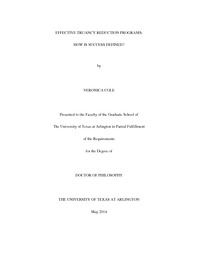
ATTENTION: The works hosted here are being migrated to a new repository that will consolidate resources, improve discoverability, and better show UTA's research impact on the global community. We will update authors as the migration progresses. Please see MavMatrix for more information.
Show simple item record
| dc.contributor.author | Cole, Veronica | |
| dc.date.accessioned | 2017-05-31T19:20:47Z | |
| dc.date.available | 2017-05-31T19:20:47Z | |
| dc.date.submitted | January 2013 | |
| dc.identifier.other | DISS-12393 | |
| dc.identifier.uri | http://hdl.handle.net/10106/26653 | |
| dc.description.abstract | This research examines how stakeholders involved with the Dallas County Truancy Court measure and define the success of truancy reduction programs. Previous studies have failed to include the perceptions of all of these major stakeholders. Judges, non-profit organizations, parents, and principals from the six districts serviced within the Dallas County Truancy Court were interviewed to assess how success was measured within truancy reduction programs. Findings indicated the measure of success among stakeholders was not consistent. This study identified the barriers associated with developing a uniform definition of success among multiple stakeholders in a decentralized arrangement. | en |
| dc.description.sponsorship | Martinez-Cosio, Maria | |
| dc.language.iso | en | |
| dc.publisher | Urban & Public Affairs | |
| dc.title | Effective Truancy Reduction Programs: How Is Success Defined? | |
| dc.type | M.P.A. | |
| dc.contributor.committeeChair | Martinez-Cosio, Maria | |
| dc.degree.department | Urban & Public Affairs | |
| dc.degree.discipline | Urban & Public Affairs | |
| dc.degree.grantor | University of Texas at Arlington | |
| dc.degree.level | masters | |
| dc.degree.name | M.P.A. | |
Files in this item
- Name:
- Cole_uta_2502M_12393.pdf
- Size:
- 2.690Mb
- Format:
- PDF
This item appears in the following Collection(s)
Show simple item record


